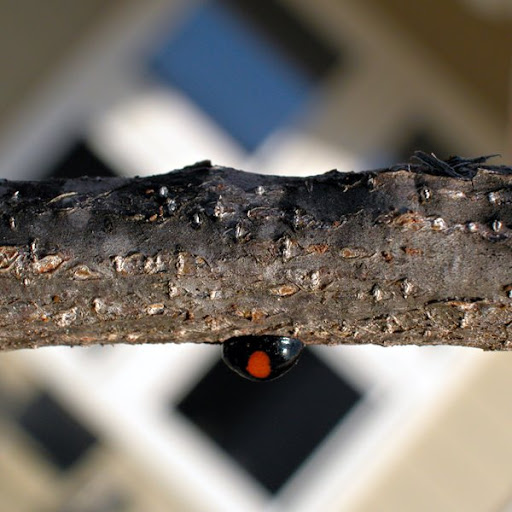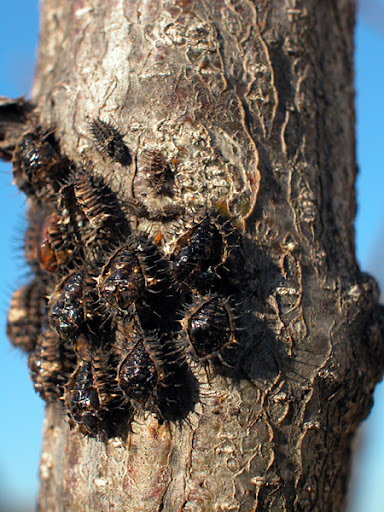
On the smaller of the two chinquapin oaks out front, we were alarmed to discover a cluster of spiny bugs surrounded by unusual black ladybugs with two orange dots. Were the ladybugs eating the spiny bugs? Were the spiny bugs eating our tree?? My mom's advice: take a bug into a nursery for identification. Also, the description sounded like a new invasive species of ladybug.


Upon trying to grab one of the spiny bugs, I realized the cluster was all empty shells.


With some quick internet research, I thought we had a British Invasion of Beatles! We were going to blame our neighbor Garreth for the appearance of kidney-spot ladybirds, Chilocorus renipustulatus, in Texas. Turns out that the British just like their bug taxonomies. It's likely the more poetic twice-stabbed lady beetle, Chilocorus stigma, which is native to the U.S.
There may still be cause for alarm: global warming. On the same tree are larvae, pupae, and newly hatched adults, long before one would expect the previous generation of adults to have become active after the winter, much less produced young that have already gone through all stages of metamorphosis. Most of our trees never fully lost their leaves, either.
Despite their half-brown foliage, the trees look much better after removing the low-hanging branches. The chinquapin oaks are slow-growing but still needed some tidying up. The American sycamores on the side street have undergone tremendous growth in their first year and had some decent sized branches to remove.


We've tentatively identified the tree in the front yard as a Mexican white oak and the one out back as a Carolina hawthorne.
In the front flowerbed, we have a wax myrtle, various grasses, Loropetalum chinesis or Chinese witchhazel, rosemary, and an unidentified fragrant plant that grows to the point of smothering itself out and makes you itch if you touch it.

The wax myrtle can grow to an astounding 15' tall and 10' wide, so we'll have to keep it well pruned. Likewise, the loropetalum is oversized for its placement, and will need to be cut to grow closer to the ground. It's beautiful, though - the only plant I really like of those that came with the house. New leaves are a deep purple, fading later to green and turning bright orange before they fall off. The bushes has stayed mostly green all winter, though, and seem to never stop blooming with bright fuschia flowers.

We're trying to figure out how to transform the bed into something more to our liking. The bushes are established by now, so we won't move them around, but the tall tufty grasses seem misplaced. We're going to fully eradicate the fragrant but itchy weeds, and may move the grasses over to fill in along the sides of the porch where they were. The rest of the grasses are going to go. We like the rosemary but would prefer to transplant it to an herb garden in the backyard. In its place, I may plant some irises, since they're my favorite flower. We'd like more flowers in general, and may plant some low-growing flowers in front of the loropetalum.
The harder planning task before us is the backyard. We wanted a vegetable garden in the narrow side yard, but as late as 9:00 this morning, it was still in the shadow of the fence. A better place may be alongside the garage, which will get sun earlier. Even that spot only gets about four hours of sun, and as the days get longer, it's not likely to ever get the six hours of sun recommended for a vegetable garden.
And that's not the only problem remaining to be solved. How do we configure the patio? Where do we put the grill? Do we eliminate the turf or leave some grassy areas? We're going to build a scale model of the yard to help us visualize our options and go from there.